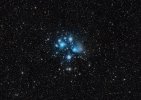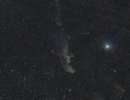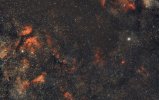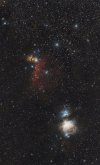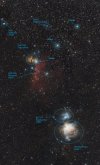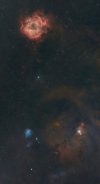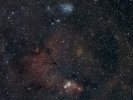- Messages
- 639
- Location
- West Sussex
Hi all.
I've recently started trying this after a few years of interest in astronomy.
I started out wanting to do some wide field Deep Sky Object imaging, so over the course of the last year or so, saved for and purchased the items needed.
All in, a decent kit can be had for £1500-£2000.
This should include a DSLR (ideally astro-modified by one of the various online vendors), Star Tracker, a decent lens such as the Samyang/Rokinon 135mm f2, a good tripod, and a few other bits & pieces such as a lens heater band, USB power bank, bahtinov mask (available on Ebay), and a wireless camera shutter controller.
Image stacking and processsing software such as Siril & Starnet++ are free.
Here are my first 3 efforts.
M31 The Andromeda Galaxy to me was an obvious first target.
I'm lucky to live in a Bortle 4 region of England.
My set up was as follows.
Skywatcher Star Adventurer 2i Pro
Canon 750D (astro modified) ISO 3200
Samyang 135mm f2 set at f2.8
322 x 30 second lights
50 flats
50 biases
50 darks
I used Siril 1.2.0 along with Starnet++
Stacking took 13 hrs 42 minutes on my old laptop...
I'm very pleased with the result.
The initial stretch did show considerable horizontal banding, but the debanding function on Siril took care of that.
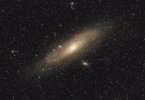
I've recently started trying this after a few years of interest in astronomy.
I started out wanting to do some wide field Deep Sky Object imaging, so over the course of the last year or so, saved for and purchased the items needed.
All in, a decent kit can be had for £1500-£2000.
This should include a DSLR (ideally astro-modified by one of the various online vendors), Star Tracker, a decent lens such as the Samyang/Rokinon 135mm f2, a good tripod, and a few other bits & pieces such as a lens heater band, USB power bank, bahtinov mask (available on Ebay), and a wireless camera shutter controller.
Image stacking and processsing software such as Siril & Starnet++ are free.
Here are my first 3 efforts.
M31 The Andromeda Galaxy to me was an obvious first target.
I'm lucky to live in a Bortle 4 region of England.
My set up was as follows.
Skywatcher Star Adventurer 2i Pro
Canon 750D (astro modified) ISO 3200
Samyang 135mm f2 set at f2.8
322 x 30 second lights
50 flats
50 biases
50 darks
I used Siril 1.2.0 along with Starnet++
Stacking took 13 hrs 42 minutes on my old laptop...
I'm very pleased with the result.
The initial stretch did show considerable horizontal banding, but the debanding function on Siril took care of that.

Last edited:
